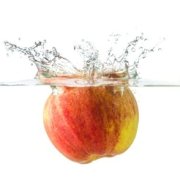Sodium (Na)
An adult contains around 100 grams of sodium. The lion's share of our sodium works in synergy with potassium and chloride as electrically charged particles called ions. Sodium and chloride are mainly found in the tissue fluids outside the cells, while potassium is mainly found on the inside of the cells. This distribution is vital for the cells and their so-called electrolyte balance that controls cellular uptake of nutrients, waste product excretion, nerve impulses, and the maintenance of essential fluid balances. The kidneys regulate the sodium levels, and it is vital that they are in balance with the body's potassium levels. A major sodium source is table salt (sodium chloride). If we ingest too much sodium it may cause a potassium deficiency and subsequent health problems.
Functions and importance for
- Maintenance of the electrolyte balance with potassium and chloride
- The body's fluid and salt balance
- Enhances the secretion of gastric juice
Deficiencies and poos utilisation may be caused by
Rarely seen, as the kidneys regulate the body's sodium excretion
- Excessive sweating
- Extreme diarrhea
- Vomiting
- Poor kidney function
- Diuretics
Deficiency symptoms
Rarely seen, as the kidneys regulate the excretion
- Indisposition and dizziness
- Heat stroke
Fatigue and muscle weakness
- Headache
Sources
Sea salt that also contains other minerals. Refined table salt. Chips, peanuts, bread, cheese, sausage, marinated and smoked foods, cornflakes, ketchup, licorice, and several other industrially processed foods often contain a lot of salt that is used as a flavour enhancer. Normally, the body's sodium requirement is covered by means of the diet without the need for extra salt.
Sodium content in mg per 100 grams
| Table salt | 38,850 |
| Sea salt | 33,800 |
| Cheese and smoked salmon | approx. 1,500 |
| Chicken, cod | 76 |
| Apple, onion | 3 |
Recommended daily allowance (RDA)
Adults: 11 years of age and older: 1,000-2,800 mg.
Children: 1-10 years of age: 500-1000 mg
Please note: Many people tend to overdose on sodium
Increased need
Rarely seen and only in connection with
- Excessive sweating
- Heat stroke
Overdosing - side effects
The Nordic Nutrient Recommendations (NNR) recommend that women keep their sodium intake below 6 grams daily and men keep their intake below 7 grams, which is the equivalent to 2.4 and 2.8 grams of sodium respectively. We generally consume far more sodium and far less potassium through our diets than we used to, and that may have adverse health implications.
- Imbalance between potassium and sodium levels
- Blood pressure increase in those who are sensitive
Different sodium compounds
Sodium is found in various salts with different biochemical effects.
Sodium chloride - table salt
Sodium ascorbate - salt of ascorbic acid. Used in e.g. non-acidic vitamin C supplements
Sodium bicarbonate/sodium hydrogen carbonate - soda and baking powder. Acidity regulator (also used against excessive stomach acid)
Sodium carbonate - soda. Acidity regulator, caustic
Sodium citrate - sodium salt of citric acid
Antioxidant
Sodium sulfite - preservative
Important information
The large consumption of sodium is mainly a result of our food being refined, nutritionally depleted, and devoid of its natural flavours. Table salt (sodium chloride) lacks other minerals, and an anti-caking agent (typically aluminum powder) has been added. Sodium plays an essential role in the animal kingdom but plants can easily do without the mineral. For that reason pure vegetarian diets often lack sodium but contain a lot of potassium on the other hand.
- Created on .












 "After about one week of taking the Q10 supplement I could feel a huge difference," says 23-year old Alan Piccini, who has been suffering from extreme fatigue and muscle aches ever since he was a child.
"After about one week of taking the Q10 supplement I could feel a huge difference," says 23-year old Alan Piccini, who has been suffering from extreme fatigue and muscle aches ever since he was a child. “Taking capsules with co-enzyme Q10 has freed me of the severe side effects of my cholesterol lowering medicine,” Mrs Franken explains.
“Taking capsules with co-enzyme Q10 has freed me of the severe side effects of my cholesterol lowering medicine,” Mrs Franken explains.